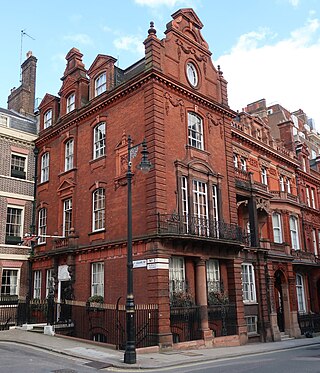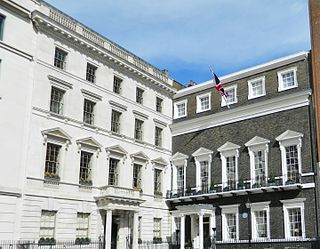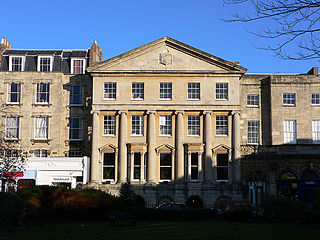
A gentlemen's club is a private social club of a type originally set up by men from Britain's upper classes in the 18th and succeeding centuries.
The Savage Club, founded in 1857, is a gentlemen's club in London, named after the poet, Richard Savage. Members are drawn from the fields of art, drama, law, literature, music or science.

A costume party or fancy dress party is a type of party, common in contemporary Western culture, in which many of the guests are dressed in costume, usually depicting a fictional or stock character, or historical figure. Such parties are popular in the United States, United Kingdom, Canada, Australia, Ireland and New Zealand, especially during Halloween.

The social season, or season, refers to the traditional annual period in the spring and summer when it is customary for members of the social elite of British society to hold balls, dinner parties and charity events. Until the First World War, it was also the appropriate time to be resident in the city rather than in the country in order to attend such events.

White's is a gentlemen's club in St James's, London. Founded in 1693 as a hot chocolate shop in Mayfair, it is the oldest gentleman's club in London. It moved to its current premises on St James's Street in 1778.

The Devonshire Club was a London gentlemen's club which was established in 1874 and was disbanded in 1976. Throughout its existence it was based at 50 St James's Street. The major Liberal club of the day was the Reform Club, but in the wake of the 1868 Reform Act's extension of the franchise, the waiting list for membership from the larger electorate grew to such an extent that a new club was formed to accommodate these new Liberal voters. The clubhouse was on the western side of St James's Street. The original intention was to call it the 'Junior Reform Club', along the model of the Junior Carlton Club formed in 1866, but complaints from the Reform Club's members led it to being named the Devonshire, in honour of its first chairman, the Duke of Devonshire, an aristocrat from a long line of Liberals.

The University Women's Club, originally the University Club for Ladies, is a British private members club founded in 1883. As the popular gentlemen's clubs did not accept any women as members, its creation was intended to provide an equivalent club accessible to women. By its own definition, it is a club for "graduate and professional women of varied backgrounds and interests". Members include lawyers, scientists, writers and musicians, as well as businesswomen.

The Arts Club is a London private members' club in Dover Street, Mayfair, founded in 1863 by Charles Dickens, Anthony Trollope, and Lord Leighton among others. It remains a meeting place for men and women involved in the creative arts either professionally or as patrons.

The Naval and Military Club, known informally as The In & Out, is a private members' club located in St James's Square, London. It was founded in 1862 for officers of the Navy and Army. It now also accepts female members, and members who have not served in the armed forces, but continues to observe service traditions.

Den Norske Klub is a social club based in London. It was founded on 17 May 1887. Its members are Norwegians living in London or Britons with a connection to or interest in Norway. It is the oldest club of its kind in the UK and is still an important meeting place for the Norwegian community in London.

Pratt's is a gentlemen's club in London, England. It was established in 1857, with premises in a house in Park Place, off St James's Street, and close to the Ritz.

The Constitutional Club was a London gentlemen's club, now dissolved, which was established in 1883 and disbanded in 1979. Between 1886 and 1959 it had a distinctive red and yellow Victorian terracotta building, designed by Robert William Edis, at 28 Northumberland Avenue, off Trafalgar Square.
The New Cavendish Club was a London private members' club, run along the lines of a traditional gentlemen's club, although it had been founded as a Ladies-only club. It was located at 44-48 Great Cumberland Place in the Marylebone district.

The Junior Carlton Club was a London gentlemen's club, now dissolved, which was established in 1864 and was disbanded in 1977.

The Green Room Club was a London-based club, primarily for actors, but also for lovers of theatre, arts and music. It was established in 1877 in a restaurant in Piccadilly Circus, and moved to premises on Adam Street in 1955, where it remained until its closure in 2004.

The Burlington Fine Arts Club was a London gentlemen's club based at 17 Savile Row.

The Athenaeum is a private members' club in London, founded in 1824. It is primarily a club for men and women with intellectual interests, and particularly for those who have attained some distinction in science, engineering, literature or the arts. Humphry Davy and Michael Faraday were the first chairman and secretary and 51 Nobel Laureates have been members.

The Clifton Club is a traditional private members club in Bristol, England, founded in 1818 as a meeting place for the gentlemen of the prosperous port of Bristol.

The City of London Club was established in 1832 and is the oldest of the gentlemen's clubs based in the City of London. Its Italian Palladian-style building was designed by English architect Philip Hardwick. Prince Philip, Duke of Edinburgh, was its royal patron.
The Chelsea College of Aeronautical and Automobile Engineering was an independent and private educational organisation established in 1924 by its principal, S C H Roberts as the Automobile Engineering College. It was formally expanded to include aeronautical engineering in 1931 in association with Brooklands School of Flying.



















